The State of Mato Grosso do Sul was created 42 years ago, has agroindustry as an economic matrix, however despite its economic dynamism, still has areas of extreme poverty. the importance of this study is the formation of a social framework sanitary pre-crisis, which will allow to elaborate a comparative for the post-crisis. The research aims to geographically locate and identify populations at social risk and describe a framework about the cycle of public policy of minimum income and its effectiveness, relating and sustainable social development between 2007 and 2017. Therefore, the bibliographic exploratory and descriptive methods was used, and analytical through cartograms of secondary sources existing in the electronic sites of the State of Mato Grosso do Sul, emphasizing the descriptive stage through legislative review of public policy in the State of Mato Grosso do Sul, demonstrating evolution, and socioeconomic and environmental interrelations.The results observed is an improvement in well-being, even with a disbelief of the purchasing power of the income voucher.
Keywords
Environment, Public policies, Regional development, Minimum income
In History social spending is high and has recently been included in public accounts. In the 16th century, the Law of the Poor of England formulated three hypotheses about the types of poor: the poor worthy of help belonging to the group of the elderly, the young and the sick; the unemployed, worthy of help, belonging to the group of those who wanted to work and did not find a job; and the unworthy poor who treated as unworthy, that is, the beggars.1 The first two groups received donations from residents and the third was treated as criminal. From industrialization, David Ricardo2 and Thomas Malthus because they understood that donations discouraged work, calling for the abolition of the Law of the Poor. Mil3 stated that the economy turned only to production and that the distribution of wealth would be a choice of society, arguing that the role of government was limited, understood that the state should intervene to help those unable to overcome themselves and give citizens the education necessary to realize their own subsistence.
The first document that outlined the concept of poverty and social welfare policies is authored by Beatrice Webb entitled Minority Report of the Royal Commission on Poor Laws,1 in which it is stated that the duty to organize the national labor market is the state, to avoid or reduce inequalities. By expanding the right to vote in European countries in the 19th and 20th centuries, there were more demands on social and wealth expenditures, health systems and public education developed with social services.
The relationship between the environment and the condition of poverty is part of the depletion of natural resources and environmental degradation, which affect the quality of life and well-being, and sometimes this population is more at risk, and often use natural resources as a means of subsistence. Sen4 says that poverty is a limitation in capabilities and functioning–the things people can do or be, are not the goods or services they have access to. This idea is reflected in the constant questions about the poverty line being absolute, in which it is necessary to meet the basic requirements, or relative as a percentage of the average income.
From this perspective, from World Bank studies to combat poverty and achievement of the Millennium Development Goals (MDGs) for 2015, and later the Sustainable Development Goals (SDGs). The SDDs attempt to guide countries' policies with international cooperation, matching the economic, social and environmental dimensions.For each of the SDDs, the means of implementing these objectives were elaborated to equalize the welfare standards between nations.
As minimum income public policies are not new in the world, it is not even an exclusively Brazilian tool. It is used throughout the developed and developing world, and it is certain that this policy is structured in a differentiated way conceptually to that of the Family Allowance Program. According to KERANEY, MOSTAG,5 universal basic income (UBI) in the USA, is a guarantee to every citizen, in unemployment situation and not only for social risk situation.
Brazil is one of the signatories of the Sustainable Development Goals (SDGs) among the 193 countries that adhere, this document has as its first objective the eradication of poverty. Devoid of any coping policy, Brazil in 2003 created a fund that would be applied in the form of income to be distributed among families that met certain conditions of education and health, currently validating itself in the Family Allowance Program of the Federal Government,6 and at the regional level, in Ticket Income, and later in the reason of environmental characteristics, the Green Allowanc7 was created at the national level.
This article described the structuring of minimum income policies in the State of Mato Grosso Sul. Located in the important area of the agricultural area, it described the socioeconomic context and has as results the incidence of the laws of payment of environmental services through the Green Allowance, Family Allowance, vale-renda and other extreme poverty mitigation programs in force before the health crisis of 2020, geographically relating as populations in a state of extreme poverty and how the State has been ordering its social policies and concludes by misconception on the part of the State between social assistance and investment, since there is a gradual flattening as to the amount of the payment.
The research aims to identify and locate geographically as a population at social risk and describe the framework about the cycle of public policy and its effectiveness, relating the GDP of the State of Mato Grosso do Sul and sustainable social development.
According to CUTTER,8 the science of vulnerability consists in the multidisciplinary integration of social sciences, natural sciences, and engineering in understanding the circumstances they put as populations at risk. It is essential to emphasize that socioeconomic factors also firmly firm their multifactorial aggregate aspect. The need for a mapping tool for spatial identification and understanding of local or regional development for integrated analysis of environmental and socioeconomic interrelations are essential for taking political policies.
Therefore, cartograms of secondary sources existing in electronic sites in the State of Mato Grosso do Sul were used, emphasizing the descriptive stage through a legislative review of the public policy implemented in the State of Mato Grosso do Sul, demonstrating the evolution, socioeconomic and environmental interrelations, in the time frame between 2007 and 2017.
The link between poverty and the environment is based on the need to develop better management of environmental and public budget planning. These analyses aim at creating tools to improve livelihoods and ways to provide opportunities for the poor, vulnerablegroups and other marginalized populations, the autonomy and enjoyment of the wealth produced by society.
Since the Federal Constitution of 1988,9 the organized sectors of civil society have been able to include Articles 204 and 205, 213, which deal exclusively with social assistance, and it is defined that it is now provided by the State to whom it needs it, regardless of contribution to social security. Therefore, from 1988 to the present day, social assistance is recognized as a public policy, and forms with health and social security the tripod of social security and an essential tool for achieving sustainable development.
The regulation of Articles 203 and 204 of the Federal Constitution (CF) only occurred years later with the approval of the Organic Law on Social Assistance (LOAS), Law no. 8,742 of 12/7/7993. By universalizing its coverage, it establishes that the organization of the national social assistance policy will be implemented through a decentralized and participatory system, consisting of social assistance institutions, both public and private. It also establishes as a deliberative body of social assistance policy, the organization of national, state and municipal social assistance councils.
The organic law of social assistance inaugurated a new order of social assistance, breaking old paradigms of clientelist and welfare, the Public Power became responsible for the promotion of dignified life for the population. Some obstacles to its full functioning hinder the access of the needy population to the recommended benefits, such as the benefit of continuous provision (BPC) that provides for the guarantee of a monthly minimum wage for people with disabilities and the elderly aged 70 years or older who prove that they do not have the means to provide their own maintenance, nor to have it provided by their family.
Together with the Federal Union, states must implement their own policies to address poverty and inequality. For all expenses included in the budget, it is mandatory to indicate the source of funding, and to enable such actions, the State Fund to Combat Poverty was created through Constitutional Amendment No. 31/2000, which was inserted article 82 of the Transitional Provisions Act (ADCT) in the CF with the following wording:[...] art.82.- States, the Federal District and municipalities must establish Anti-Poverty Funds, with the resource that this article is intended, and these funds must be managed by entities that have the participation of civil society.
§1-For the financing of State Funds and under the conditions defined in the supplementary law of art. 155§2, XII, of the Constitution, not applying, on this percentage, the provisions of art. Me, the Constitution.
The single rate adopted by the State of Mato Grosso do Sul is 2.0% fixed, authorized by State Law No. 4,751 of 11/05/2015, and is like the states of more than more than the federation except for Alagoas, Amazonas and Piaui, which have a variation between 1% and 2%, Rio de Janeiro has up to three differentiated rates for products up to 4%, and the states of Pará, Amapá and Santa Catarina, have not yet regulated (www.nfe.fazenda.gov.br>portal). The competence is state and works as an additional rate in the collection of ICMS, only for superfluous consumer goods. The fight against povertyis based on the minimum income programs promoted by the Federal Government.
At the same time, with the understanding of the state's role as a development inducer, since 2007, the State of Mato Grosso do Sul began to develop tools to cope with social vulnerability, since at the federal level, the Family Allowance Program (BPC) had been implemented since 2004. The creation of BPC in Brazil on 01/09/2004, occurred because of a pilot project implemented in the municipality of Campinas by the City Hall. As a result of the research,it was found in the field research that such benefits are intended exclusively for women heads of household, because the participating men did not allocate the values in benefits of the family nucleus.10 Several assistance programs were developed, such as scholarship school, National Food Access Program-PNAA, Minimum Income Program linked to Health-Food Grant, Gas Aid Program. To improve governance in resource management, all these programs were added into one that were initially fully financed by the World Bank, through Provisional Measure No. 132 of 10/20/2003.
Currently these resources are transferred to the Estates, which through agreements to the State Departments and has as attribution the burden of management, that is, the identification of families in a situation of social risk, so that it is effective, and that it is not granted in duplicate to the same family. From 2011, within the scope of the Family Allowance Program, the Federal Government instituted the Green Allowance Program, which is being implemented in an integrated manner to the Single Registry (CadÚnico). Bolsa Verde is intended for traditional peoples and communities, and aims to combat poverty in rural areas, and simultaneously encourages such communities to conserve natural resources, reducing ecosystem degradationi and deforestation in:
i. Sustainable Use Conservation Units in the Categories National Forests (FLONAS), Federal Extractive Reserves (Resex), Sustainable Development Reserves, all managed by the Chico Mendes Institute for Biodiversity Conservation (ICMBio);
ii. Territories occupied by riparians, extractivists, indigenous populations, quilombolas, and other traditional peoples and communities
iii. Environmentally Differentiated Settlements of agrarian reform, under the management of the National Institutes of Agrarian Colonization (INCRA);
iv. Other rural areas considered priority by act of power Executivo.
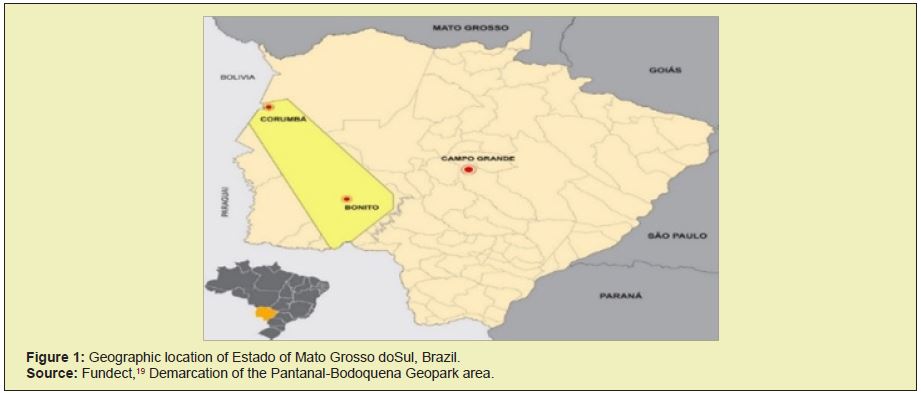
Footer:
- iQuilombos are territories of cultural resistance and are remnants of racial ethnic groups that identify themselves. With their own trajectory, endowed with specific territorial relations, with presumption of black ancestry related to the struggle and historical oppression, they self-determine black community of quilombos, given the costumes, such as traditions and specific cultural and economic conditions that are distinguished from other sectors of the national community.Brazil. Brazil Quilombola Program. Secretariat of Policies for Traditional Communities. 2004. Available in: https://www.gov. br/mdh/pt-br/navegue-por-temas/igualdade-racial/artigos-igualdade-racial/programa-brasil-quilombola. Accessed: 15 Feb. 2021.
The Green Allowance has as its central concept the Payment for Environmental Services (PSA), which translates an economic value of the protection of ecosystems and their sustainable use, since it is the communities that collaborate for forest conservation. The State of Mato Grosso is characterized by the cerrado biome, and has as its main conservation area, among other areas, the Bodoquena mountain range in Figure 1.
This area consists of 45 geosites and two sites of cultural interest and form the Bodoquena Geopark, and the main area contemplated by PSA. State Law No. 5,235 of 07/16/2018, began to regulate the projects, but has not yet replaced the execution via the Single Register. Similarly, to the Family Allowance Program (PBF), in the State of Mato Grosso do Sul, the Ticket Income Program (PVR) was created in December 2007, which, like PBF, makes the payment of a monthly amount to families at social risk, located in both rural and urban areas.With improvement of the program's implementation, it is currently supported by Law No. 4,902/2016 and regulated by State Resolution No. 200/2019.
During the implementation of the Vale Renda Program, several legislative changes were implemented with the task of improving the management of the spatial coverage of the program and has as one of the conditioning factors the referral of beneficiaries to job vacancies made available through the State Labor Foundation. This is the main differencebetween the programs, reflecting the promotion of autonomy in relation to the State and the south-country society of south Mato Grosso.
According to Correa Monteiro et al.,11 the State of Mato Grosso do Sul has as its centralized development process as an occupation of the national agricultural frontier. The state capital, between the 1960s and 1970s, began the separatist process with structural and conjunctural transformations, and presented a strong migratory process for the region. This process is understood from the aspect of attraction or expulsion, that is, the attraction of inter media capital to the formation of a diversity, which enables,at the same time, a cultural diversity as well as an economic diversity, validating an economy based on the rural sector.
The division of the State of Mato Grosso occurred on 11/10/1977, brought a new dynamic to the local economy, starting with the installation of state government, which until the data were in Cuiabá, Mato Grosso. The strong investments in hiring new people, a factor that contributed to the acceleration of the migration process to the state capital,12 generated a new wave of development, which required the rulers of the new state, the elaboration of social policies aimed at creating new jobs, and basic housing conditions for low-income populations, who expelled from the countryside by the process of modernization of agriculture, sought in the city their satisfaction of their needs.
The consequences of the rural-urban movement in state, which seeks the conditions offered by the city, result in the need for care by public and private assistance institutions, of the basic needs demanded by the population.This fact shows unequivocally that it was extremely important togenerate jobs for the workforce that emerges,as well as create housing conditions, an urban and social structure for this contingent.13
Nevertheless, the state and municipalities soon after the division did little to ensure the development and implementation of social programs to combat poverty, which, pairgrew alarmingly in the peripheral regions of the municipalities: [...] The rural exodus and this exacerbated urbanization process, caused largely by land concentration (...) and the fragility of specific programs to ensure satisfactory conditions of man's fixation in rural areas, began to put sharp pressure on government investments in socio-urban equipment, in particular education, health, sanitation, housing and transport. In Mato Grosso do Sul, these factors were associated with a significant situation of deficiencies, resulting from the low rate of investments in the social area in previous years, causing trends of deterioration in the quality of life of the inhabitants.14 The need to implement mechanisms to mitigate the effects of accelerated economic development, and promotion of well-being by the State, was preceded by specific legislation, in which it began to manage direct transfers to the population at social risk, and which were temporally in line with the advent of the new legislative frameworks.
Studies on inequalities in the context of regional development permeate, in the first approximation, the study of vulnerabilities, their territorial situation, affected populations and socioeconomic surveys, so that the reasons for occurrence are extracted. From this understanding it is possible for Estado to guide mitigation and prevention actions.The minimum income policies increased in the world since the end of World War II, being an important instrument for coping with multidimensional poverty.
In Brazil, minimum income programs are one of the coping instruments, and it is added in parallel to the program to combat malnutrition within the Federal Government. The Estado has in the field of education, the University Valley, and the Valley Indigenous University. All these tools are structured according to the model below:
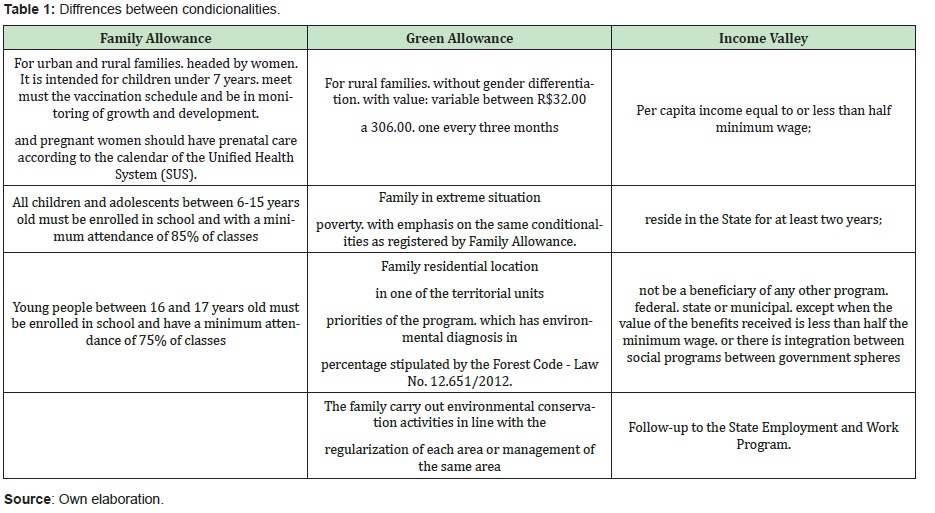
The Figure 2 demonstrates the centrality of management through the Single Registry in antecedent way. Secondlyit isobserved that the effectiveness of minimum income programs permeates the completion of conditionalities, and each program has different requirements for different population groups that are divided into each other: Table 1.
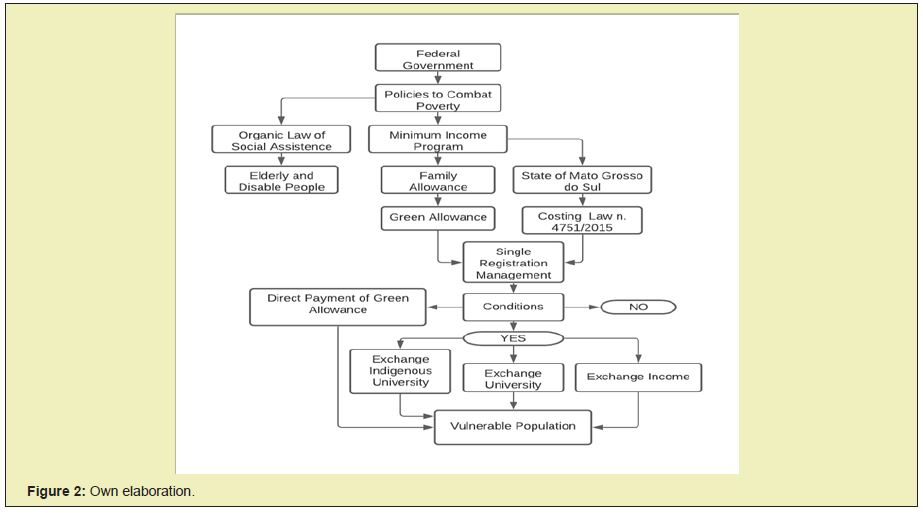
The peculiarity of Green Allowance is that it has a differentiated regulation to the others, having been first regulated by Decree No. 7,572/2011 of 09/28/2011 being added by the Forest Code of 2014, which regulates the areas regardless of the political limits of each state of the federation:
[...] art. 12.-All rural property must maintain the area with native vegetation cover, as a Legal Reserve, without prejudice to the application of the rules on permanent preservation areas, observed the following minimum percentages in relation to the area of the property:
I- Located in the Legal Amazon:
- a. 80% (eighty percent) in the property located in the forest area;
- b. 35% (thirty-five percent), in the property located in a cerrado area;
- c. 20% (twenty percent) in the property located in the general field area.
The implementation of Green Allowance occurred in 2012, in the Region of the Legal Amazon, and from 2014 it extended to another area described above. Conservation activities comply with those in the management or regularization instruments of each area, which describe and establish the rules of use of natural resources, occupation of and coexistence of the beneficiaries of the unit. As activities of sustainable use, they value the forest standing and guarantee not only its existence, but also the population fixation, economic survival of forest activity, and that the resources provided by it avoid its overthrow. Such conditionalities enter the state's management objectives, which also confers economic value on communities. The vulnerability indicators between Brazil and Mato Grosso do Sul have important differentials, in which the second has a smaller picture than the rest of the country, but still persistent conforms below is shown in Table 2.

The data contained in the Single Register dated February 2014 extracted by the State Government, the number of registered families was 387,076, with income by family raising up to half the minimum wage. Comparatively, we can affirm that the situation of vulnerability in Mato Grosso do Sul in relation to the country is symmetrically more favorable. With an HDI at 0.729 and tenth best (Table 3).15 From the data above the program, it served more than 30% of the population located in these municipalities.there is still a picture of certain groups unassisted populations, such as camped, quilombolas and terreiros, which in relation to the other states of the Midwest region-State of Mato Grosso, State of Mato Grosso do Sul, Federal District and State of Goiás, have the following quantitative in Figure 3:
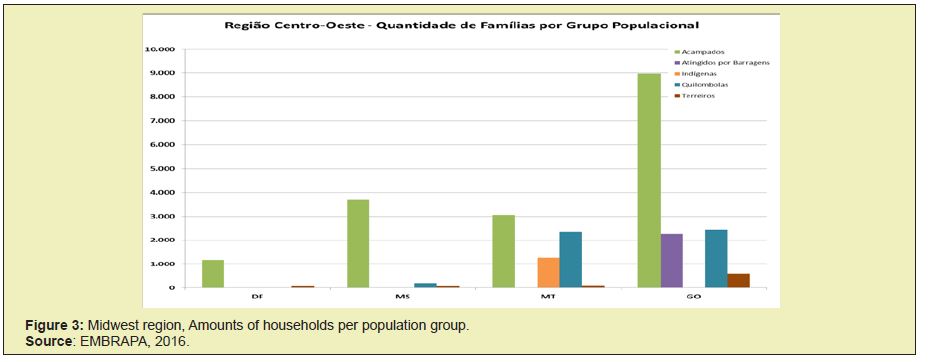
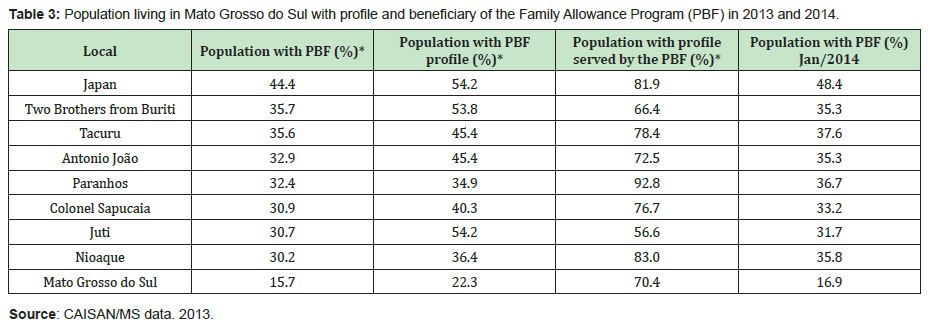
Environmental quality contributes directly or directly to economic development and employment. Although the State presents a less worrying picture in relation to the others, in some of the populations analyzed, the number of camped is the second largest in the region. As indigenous communities and quilombolas are geographically distributed as follows:
It is observed territorially that the indigenous population occupies the central region and the southern region, mostly. The quilombola population, conversely occupies the central region and to the north:
According to data from the Interstate Chamber of Food and Nutrition Security,16 the Vale-Renda program did not benefit 60,000 families, referred to professional qualification courses more than 7,000 beneficiary families, and disconnected from the program due to the improvement of monthly income per capitaand thatexceeded the poverty range.
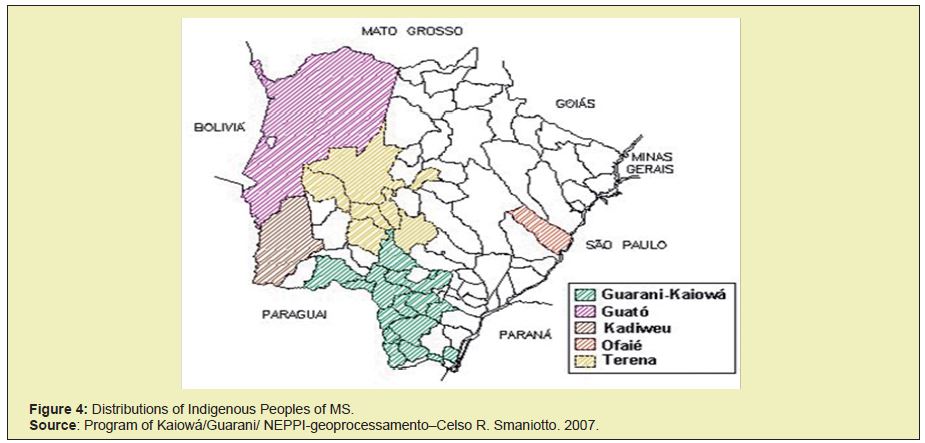
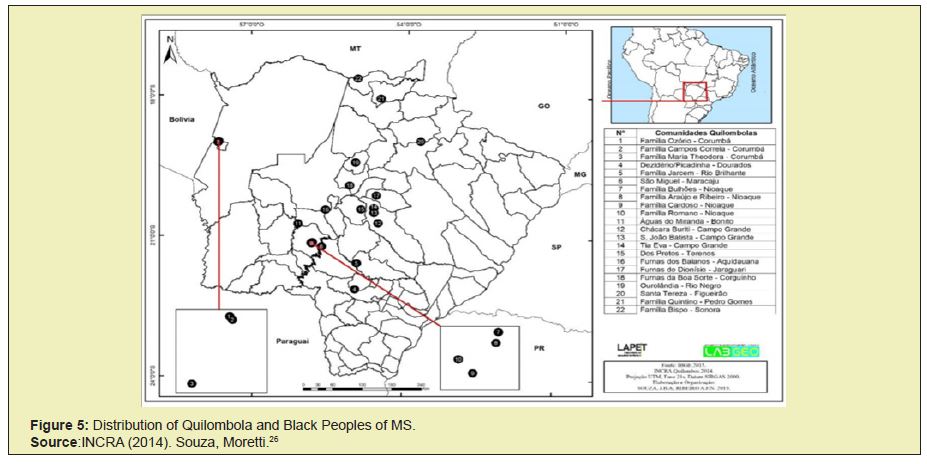
It can be affirmed that the population at social risk is indigenous (Figures 4&5), because it is noticeable that the southern region has extremely high and high points of vulnerability. Because the minimum income coverage is shown to be in deficit, the food distribution program was elaborated in order to remove these populations from the situation of social risk.
The data regarding the evaluation of the nominal values of the remuneration of minimum income programs, it is possible to affirm that over the years of the execution of the programs, both at the federal and state level, all programs had the following performance in relation to the minimum wage(Figure 6).
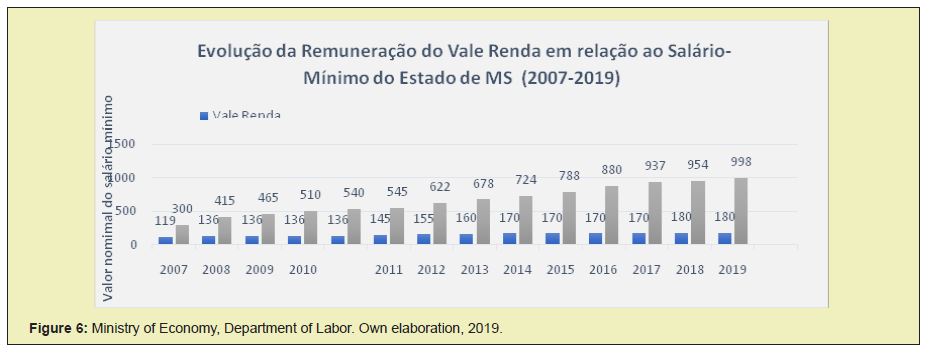
We can infer that such flattening has the effect of creating new mitigation tools. Regarding work conditioning, the data on poverty corroborate the implementation of the benefit-work binomial as an essential condition for vulnerability mitigation. Since the creation of Vale Renda in 2007, local minimum income policies have always conditioned the receipt of employability. In this conditional relationship, the labor market in the 79 municipalities of the state performs as follows (Figure 7).

There is a flattening in the relationship between the nominal values of the minimum wage and the income voucher. However, it is possible to affirm that in the relationship between economy and development, it can be affirmed that policies are corresponding to the final goal of cooling poverty, since the State, according to IPEA data,17 is located in the fifth place in the lowest rate of social vulnerability in relation to the states more of the federation, which reinforces that the correctness of the policy of implementing the benefit-work binomial as an essential condition for mitigating vulnerability. 18–26
The Post-War undertook major changes in the evolution of peoples coming to modify the environment more expressively through numerous technological advances. According to Sen,4 when discussing development from the perspective of human freedoms, the growth of gross national product (GNP), or individual incomes, is important to expand the freedoms enjoyed by members of society. It happens that freedoms also depend on other determining factors, such as social and economic conditions, food, education. The incorporation of the Green Stock Exchange in the Single Register requires revision in the execution, as it promotes the assistance perspective that is nonexistent in any aspect of observation. Payments for environmental services cannot be linked to social assistance, but it is investment. The link in CadÚnico keeps the extremely low remuneration of this investment because it conceptually confuses it with assistance without being.
In view of the other aspects observed, the data on poverty corroborate the decision, not only of the implementation, but also of the maintenance of the minimum income program. Considering that there was an improvement in vulnerability in the entire State of Mato Grosso do Sul in the temporal context of the analysis,it occurs that when locating and identifying by population the one that make up the vulnerability, it is possible to affirm that the state demands a multidisciplinary work, which will not only condition ittowork, but understand the ethnography that constitutes the State of Mato Grosso do Sul,in order to ban it altogether. The incorporation of Green Allowance in the Single Register needsrevision, in order not only to mitigate vulnerability through autonomy, but to promote the inclusion of such populations in the wealth of the State and premise of sustainable development.
None.
None.
Author declares that there is no conflict of interest.
- 1. Gahan Peter. Bernard Shawn and Beatrice Webb on Poverty and Equality, (1905–1914). London: UK; Palgrave MacMillan. 2017.
- 2. Ricardo David. The Dutch and Portuguese–Jewish background of David Ricardo. The European Journal of the History of Economic Thought. 2016;11(2):281–294.
- 3. MILL John Stuart. Principles of Political Economy. São Paulo: Ed Hail; 1848.
- 4. Sen Amartya. Development as Freedom. Trad. Laura Teixeira Mota. São Paulo: Ed. Companhia das Letras. 2015.
- 5. Kearney Melissa S, Mogstad Magne. Universal Basic Income (UBI) as a Policy Response to Current Challenges. Maryland, The Aspen Institute. 2019.
- 6. Brazil. Provisional Measure No. 132. Converted into Law No. 10,836, 2004. Official Gazette of the Federative Republic of Brazil, Executive Branch, Brasília, DF. 2019.
- 7. Brazil. Executive Decree No. 7,572/2011. It regulates provisions of Provisional Measure No. 535. which deal with the Environmental Conservation Support Program–Bolsa Verde Program. 2011.
- 8. Cutter, Susan. The science of vulnerability: models, methods and indicators. Critical Journal of Social Sciences. 2019;93:59–69.
- 9. Brazil. Federal Constitution of 1988 amended by Constitutional Amendment No. 91. Official Gazette of the Federative Republic of Brazil, Executive Power, Brasília, DF. 2016.
- 10. Ministry of Social Development. BPC PRIMER. 2017.
- 11. Corrêa Alexandre S, Monteiro Marcelino A, Rippel Ricardo, et al. Migratory Flows in the state of Mato Grosso do Sul (1970–2010). Rev Interactions. 2018;19(2):325–341.
- 12. Bittar Mariluce. Mato Grosso do Sul, the construction of a state: regionalism and divisionism in southern Mato Grosso. Campo Grande: Ed. UFMS. 2009.
- 13. Buainain Antonio M, Alves Eliseu, Silveira José Maria, et al. The rural world in 21st century Brazil. The formation of a new agrarian and agricultural standard. 2014.
- 14. IPEA. Institute of Applied Research. Social Policies: monitoring and analysis. 2015.
- 15. IBGE. Brazilian Institute of Geography and Statistics. Atlas Brazil. 2019.
- 16. Costa Carlos RM, Costa Silvana RM. State Social Protection: from Elizabethan laws to the Welfare State. International Public Policy Day of UFMA, VIII, 2017. São Luís, Electronic Schools. Sao Luis/MA. 2017.
- 17. IPEA. Instituto de Pesquisa Aplicada. Atlas da Vulnerabilidade Social nos Municípios Brasileiros. 2015.
- 18. Alves Ismael Gonçalves. Charity to welfare state: a brief essay on the historical aspects of Western social protection systems. Ciência e Cultura. 2015;67(1).
- 19. FUNDECT. Foundation for The Development of Science and Technology of the State of Mato Grosso doSul. Bodoquena Pantanal Geopark. 2019.
- 20. Ferreira De Souza, Pedro H. Guimarães. The inequality seen from the top: the concentration of income among the rich in Brazil. Thesis. PhD in Sociology–Institute of Social Sciences, University of Brasilia, Brasília. 2017.
- 21. Government of the State of Mato Grosso do Sul. Interstate Food and Nutrition Safety Chamber. State Plan for Food and Nutrition Security. 2014.
- 22. IBGE. Brazilian Institute of Geography and Statistics. Atlas Brazil. 2013.
- 23. Me. Ministry of Economy. General Register of Employees and Unemployed– CAGED. 2019.
- 24. Rotta Cristiano V, Hegenberg Juliana T, Santos Maria C, Nascimento Décio E, Silva Christian L. Proposition of Criteria for The Construction of Indicators Focused on Governance, Health and Well–Being and Coexistence. In: A Global City Project “Innovative Cities: Curitiba 2030. RBPD – Revista Brasileira de Planejamento e Desenvolvimento. 2012;1(1):99–113.
- 25. Sedhast. Secretariat of Human Rights, Assistance and Work of Mato Grosso do Sul. Bulletin. 2012.
- 26. Souza João BA, Moretti Edvaldo C. Formation and Resistance of Quilombola Communities in the Municipality of Corumbá–MS. Revista Entre Lugar. 2019;10(20).

